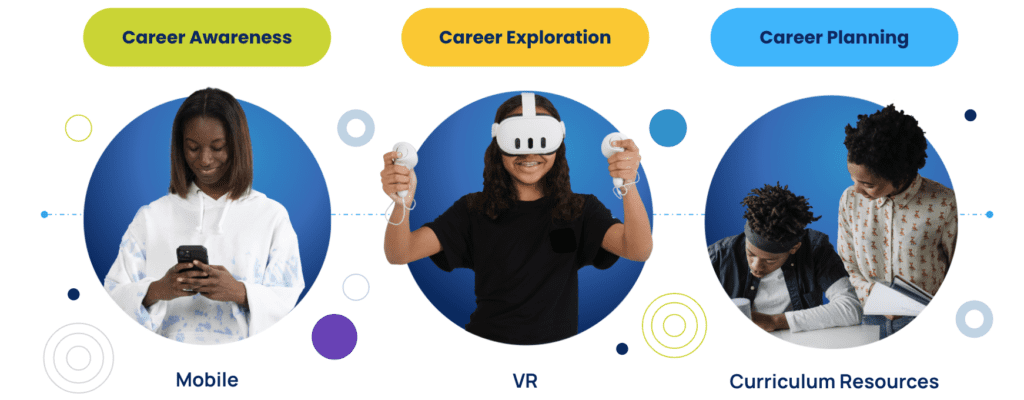The world of work is changing at an unprecedented pace. Advances in artificial intelligence (AI), automation, and extended reality (XR) are helping businesses create efficiencies and reskill workers to compete in a new technology-driven environment. To succeed, learners need more than just knowledge — they need the ability to adapt, grow, and continuously discover their potential.
Every industry today will be transformed. AI can now write legal briefs, automation runs entire warehouses, and workers train in virtual spaces before touching real equipment. But these technologies aren’t just disrupting jobs — they’re creating new roles that blur traditional career boundaries. A former truck driver might become a fleet logistics programmer, while a retail worker could transition into managing automated checkout systems.
The old rules don’t work
Recent graduates and career changers alike are finding that old career-search strategies no longer guarantee success. An English degree and traditional job search efforts might not compete with AI writing tools. Even a law degree, once considered a safe bet, may not provide the expected return on investment.
The World Economic Forum predicts that 50% of workers will need reskilling by 2025, but traditional training methods can’t keep pace. This skills gap presents a growing challenge.
Opportunity amidst a growing labor shortage
While traditional work is changing, a severe labor shortage is looming in the United States, with economists predicting a 6 million worker deficit by 2032 as population growth outpaces labor force growth by nearly 8 to 1. This shortage is driven by multiple factors:
- An aging workforce: Baby Boomers are retiring in large numbers.
- Shifting demographics: Population growth is outpacing labor force growth.
- Skills mismatch: Many job seekers lack the skills needed for in-demand roles.
These dynamics present a significant opportunity for those who pursue training in fields like healthcare, skilled trades, and essential services. Construction and healthcare, in particular, have numerous openings. These hands-on, difficult-to-automate roles offer increasing job security and earning potential as the labor shortage intensifies.
Transfr Trek: A new approach to career exploration
Transfr Trek offers a solution. Instead of generic advice, Transfr Trek provides comprehensive career exploration and interactive work simulations. It democratizes career exploration, making it accessible and engaging for everyone from K-12 students to adults seeking new careers.
Imagine a student exploring manufacturing by troubleshooting a virtual assembly line, or a potential healthcare worker practicing patient intake in VR. Transfr Trek provides this kind of real-world experience before individuals commit to a career path.
Transfr Trek’s features support learners in all phases of career exploration:
- Career awareness: Real-time job outlooks, wage data, regional pathways, and personalized career matching.
- Career experience: Interactive VR simulations offer a “day in the life” perspective on various professions.
- Career planning: Tools for setting career goals, creating action plans, and tracking progress.
A modern solution for a dynamic workforce
Transfr Trek is built around the notion that learning is continuous. It provides tools and frameworks for ongoing career development.

Unlike traditional education models, Transfr Trek acknowledges that careers are no longer linear; workers may change roles and industries multiple times throughout their lives.
Key advantages of Transfr Trek:
- Connected, immersive experience: Career exploration that uses interactive assessments, VR simulations, and personalized career matching.
- Classroom-to-career pathway: Support for the entire career development journey
- Focus on non-traditional pathways: Includes skilled trades and apprenticeships, not just college paths
- Affordability and value: A comprehensive solution at a competitive price point
- Continuous improvement and innovation: Ongoing research and development ensures Transfr Trek remains at the forefront of career exploration technology.
Building a stronger workforce and communities
Transfr Trek is more than a technology product — it’s a tool for lifelong learning and workforce equity. By partnering with schools, nonprofits, and community organizations, Transfr aims to ensure that everyone has the opportunity to explore fulfilling careers and achieve upward economic mobility.
As we look to the future, solutions like Transfr Trek remind us that education and career development are not endpoints but evolving journeys. By empowering individuals to secure in-demand jobs and provide for themselves and their families, you’re not just creating a brighter future for them; you’re building a stronger and more vibrant community that can provide new opportunities for economic growth to future generations.
We’re thrilled to partner with you in this mission.
Discover how Transfr is reshaping career exploration.

